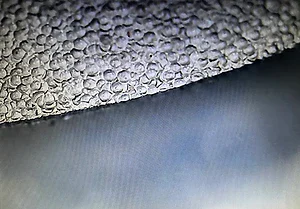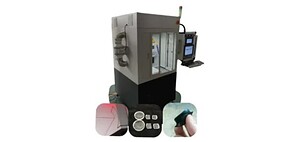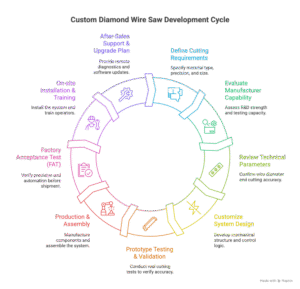Einführung
Modern manufacturing increasingly depends on high-precision cutting technologies to process advanced materials such as sapphire, silicon carbide, optical glass, quartz, ceramics, and graphite. Traditional cutting tools—including blades, band saws, and reciprocating wire systems—tend to generate excessive heat, wide kerf loss, micro-cracks, and inconsistent surface textures.
Modern Drahtschneidetechnik addresses these issues by providing:
- Extremely narrow kerf width
- Low thermal impact
- Smooth cutting surfaces with minimal post-polishing
- High compatibility with ultra-hard and brittle materials
- Reliable slicing for thin wafers and special geometries
With the development of closed-loop diamond wire, servo tension control, and intelligent CNC feeding mechanisms, wire cutting has become a key technology across optics, semiconductors, research labs, and precision manufacturing.
The Physics Behind Abrasive Wire Cutting
Modern wire cutting technology is built upon the mechanical interaction between diamond abrasives and the material surface. Three core mechanisms define this process:
Abrasive Interaction
Diamond particles remove material through micro-cutting and localized brittle fracture.
- Hard materials require sharper exposed diamonds and higher wire speeds.
- Brittle materials require stable tension and low vibration to prevent chipping.
Continuous Wire Motion
One of the biggest advancements is the use of endless loop diamond wire, which moves continuously in a single direction, unlike traditional spool wire that moves back and forth.
| Motion Type | Merkmale | Cutting Result |
|---|---|---|
| Continuous loop wire | Einseitig gerichtete Bewegung | Up to 80 m/s, low vibration, smoother surface |
| Spool wire | Reciprocating motion | Reversal marks, lower efficiency |
ontinuous motion ensures consistent abrasive contact, uniform material removal, and improved stability.
Heat and Chip Management
High-speed motion improves chip evacuation, while cooling or lubrication reduces frictional heat.
This minimizes thermal damage, making it suitable for sensitive optical, semiconductor, and ceramic materials.
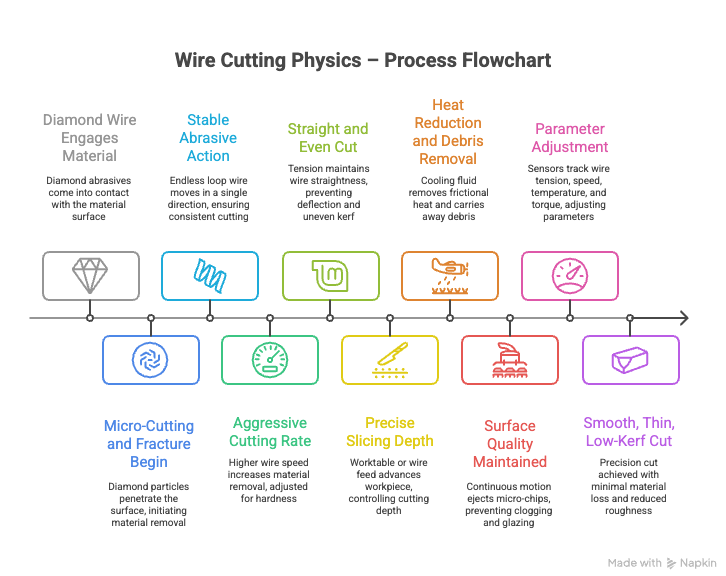
Key Parameters That Define Cutting Performance
Wire cutting depends on precise coordination of tension, linear speed, and feed rate.
Drahtspannung
Tension determines straightness, stability, and surface uniformity.
| Parameter | Low Tension | High Tension |
|---|---|---|
| Suitable For | Brittle materials | Hard materials |
| Benefits | Reduced cracking | Faster cutting |
| Einschränkungen | Slower | Higher risk of breakage |
Modern equipment uses servo or pneumatic tension systems to maintain stability during long cutting cycles.
Linear Wire Speed
Wire speed influences cutting efficiency and surface finish:
- General industrial range: 50–80 m/s
- Optical glass: Lower speed for fine surfaces
- SiC & sapphire: Higher speeds improve cutting rate
Feed Rate
Feed speed must be matched with material hardness and wire performance:
- Optical materials: ~10 mm/min
- Graphite: 15–30 mm/min
- Ceramics: moderate, stable feeding
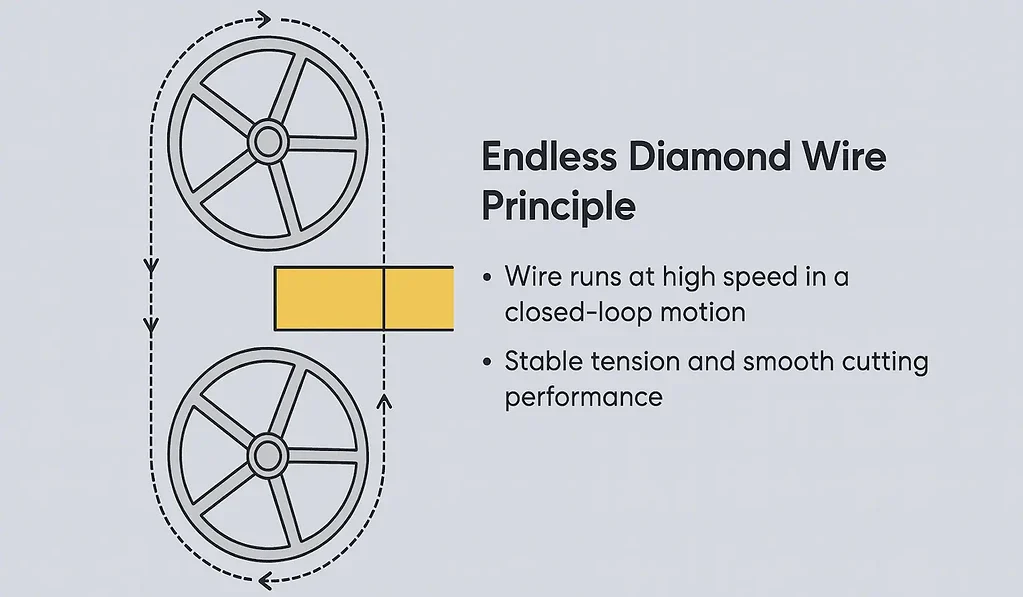
Control Systems for Precision Slicing
Modern wire saws rely on CNC or PLC control systems to achieve consistent, high-precision slicing.
Automated Thickness Control
The machine automatically feeds by a preset slicing thickness, delivering:
- Stable repeatability
- Uniform slice dimensions
- Precision up to ±0.03 mm in advanced systems
Multi-Axis Cutting Capabilities
Advanced systems can include:
- Rotational axes
- Tilting axes
- Contour cutting paths
This allows for cutting of prisms, cylinders, irregular profiles, complex graphite structures, and specialized ceramics.
Real-Time Monitoring and Safety Functions
Typical advanced functions include:
- Wire break detection
- Real-time tension feedback
- Cooling or lubrication monitoring
- Speed and torque monitoring
- Emergency stop and auto shutdown

Application Scenarios and Comparison
Endless Wire Cutting vs. Spool-Type Wire Cutting
| Merkmal | Endloser Diamantdraht | Spool-Type Wire |
|---|---|---|
| Motion | Continuous | Reciprocating |
| Max Speed | Bis zu 80 m/s | ~20 m/s |
| Vibration | Sehr niedrig | Higher |
| Oberfläche | Very smooth | Reversal marks |
| Wartung | Simple | Complex |
| Typical Use | Sapphire, SiC, optics, ceramics, graphite | General materials |
Precision in Thin Slicing
Modern systems deliver:
- ±0.03 mm thickness precision
- Minimal kerf loss
- Reduced need for secondary polishing
This is crucial for optical filters, sapphire wafers, semiconductor substrates, precision graphite components, and high-value brittle ceramic parts.
Abschluss
Modern wire cutting technology combines:
- High-speed continuous loop diamond wire
- Intelligent tension control
- Precision CNC feeding
- Stable abrasive interaction with minimal heat
The result is a cutting process that offers:
- High accuracy
- Low material loss
- Excellent surface integrity
- Reliable performance for brittle and ultra-hard materials
For industries such as optics, semiconductors, aerospace, advanced ceramics, carbon composites, and high-purity graphite processing, wire cutting systems have become an essential tool for both research and production environments.
👉 Learn more about our complete range of industrial wire saw systems: https://www.endlesswiresaw.com/wire-saws/





